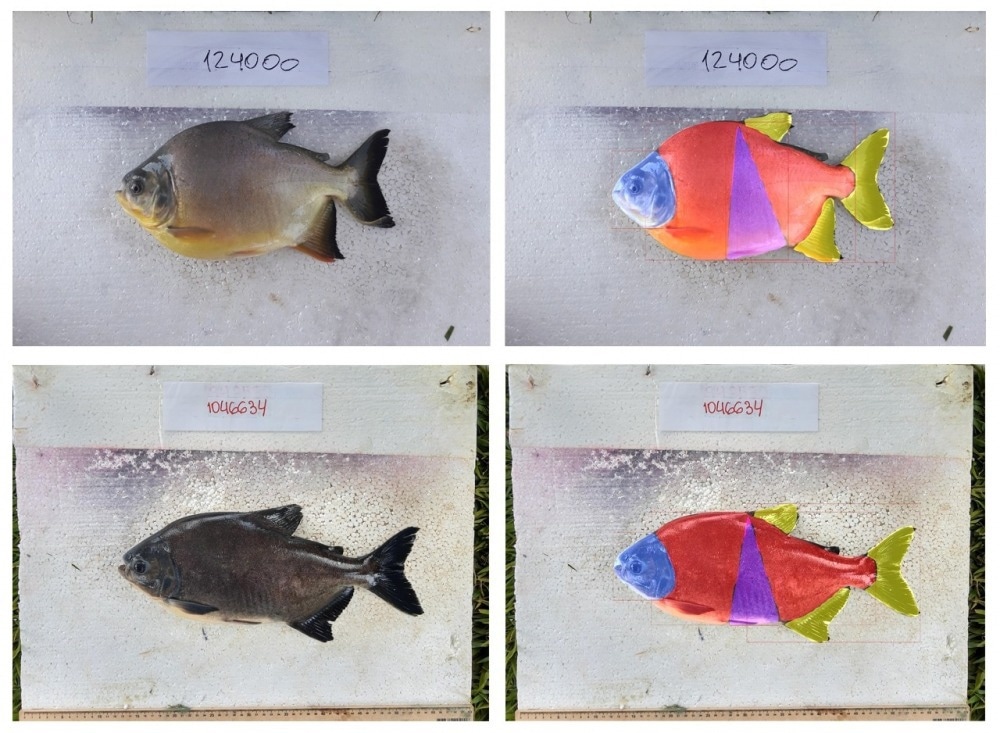
Software developed by Brazilians automatically measures pacus using artificial intelligence. Specimens with round body (top) and elliptical body. On the right, parts selected by the program via machine learning. Image Credit: Diogo Hashimoto/UNESP
Their growth could be tracked with a tape measure, and they could be weighed on a scale. Then, tabulation and comparison of the data can be done. However, to breed a full population with the appropriate characteristics, around 2,000 fish per generation should be quantified and weighed, and the task could take days.
In Brazil, scientists at São Paulo State University (UNESP) have resolved this issue by engineering software that makes use of artificial intelligence to make precise measurements in real time. The study outcomes are reported in the Aquaculture journal.
The research team has been working for some time on the genetic enhancement of this native species to increase yields while reducing production costs.
When you measure the fish manually, you get less data because you stress them and can transmit disease leading to outbreaks, not to mention the valuable time taken. We automated the process, training the machine with photos of pacus, and labeling head, body, pelvic girdle and fins. We now have a portable device that can be taken into the field to do this quickly and classify the best animals.
Diogo Hashimoto, Study Corresponding Author, Aquaculture Center, São Paulo State University
A professor at UNESP’s Aquaculture Center in Jaboticabal, Hashimoto leads a project assisted by FAPESP.
The scientists made use of deep learning, one of the newest kinds of machine learning, thereby producing results in a much quicker way, among other benefits. The use of the innovation was made feasible by a project that has been partially supported financially by Huawei do Brasil Telecomunicações and headed by Jose Remo Ferreira Brega, a professor in the Department of Computing at UNESP’s School of Sciences in Bauru and penultimate author of the article.
In the latest study performed, the scientists set forth to differentiate round-bodied from oval-bodied pacus. The species consists of a round body in the wild, and this trait is thought to impact buying decisions by consumers.
Fish farmers achieve it by choosing individuals with the perfect height-to-width ratio to achieve greater yields in loin and rib and the cuts wished by consumers of native fish like tambaqui and pacu.
For instance, other measurements, like pelvis size or head-to-body ratio, could be utilized as indicators of growth rate, fillet yield, and weight gain.
Genetic Improvement
Breeders tend to make use of phenotype selection for genetic enhancement across the Brazilian farm sector, which is known to be the world leader in the production of animal protein obtained from beef cattle, pigs, and chickens.
But in fish farming, this kind of technology is available only for tilapia and salmon, both of which are known to be exotic species and mass-produced globally. This has the majority of the innovations coming from abroad.
Our program can recognize and measure the different parts of the pacu even at the side of the tank, with bottom visual pollution and variable light conditions. The systems developed for tilapia use controlled light and a standardized bottom.
Diogo Hashimoto, Study Corresponding Author, Aquaculture Center, São Paulo State University
Systematization of pacu phenotypes in huge databases will allow breeders to choose animals with higher precision.
In this article, the authors explain simple nucleotide polymorphisms (SNPs) for pacu and tambaqui (Colossoma macropomum). Such genetic code mutations could be utilized in the genomic mapping of the traits that are known to be suitable, thereby expediting selection and improvement.
The advantage of integrating our software with genomic data is that we can collect the necessary information and keep the animal of interest alive for use as a reproducer during the selection process.
Diogo Hashimoto, Study Corresponding Author, Aquaculture Center, São Paulo State University
Journal Reference:
Freitas, M. V., et al. (2022) High-throughput phenotyping by deep learning to include body shape in the breeding program of pacu (Piaractus mesopotamicus). Aquaculture. doi.org/10.1016/j.aquaculture.2022.738847.